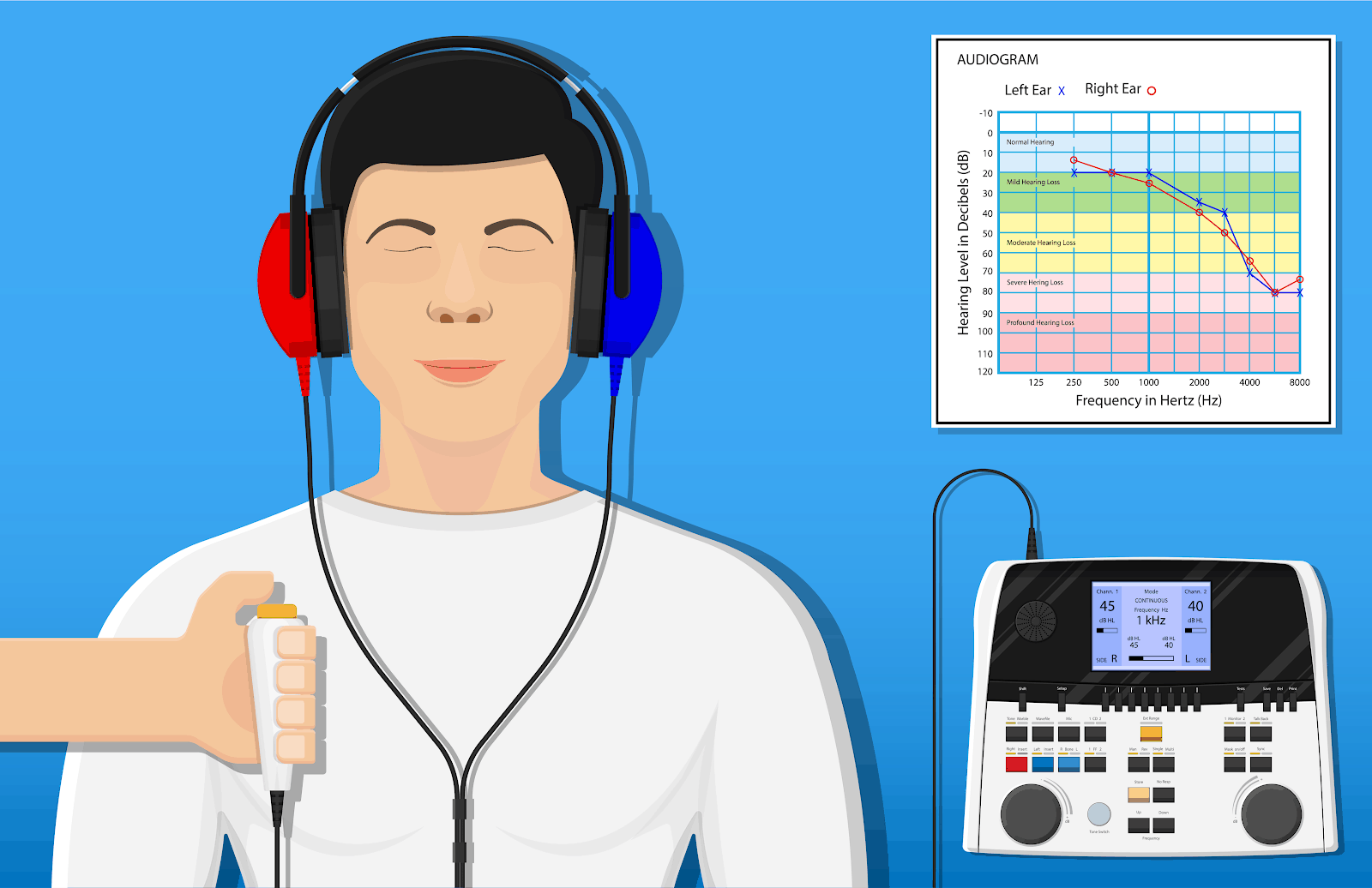Hearing allows us to communicate and connect with the world around us. Thus hearing test is necessary at times.Unfortunately, hearing loss is a common problem that affects millions of people. One way to determine the extent of hearing loss is through a puretone audiometry test. In this article, we will discuss what a puretone audiometry test is and what to expect during the test.
What is a Puretone Audiometry Test?
A puretone audiometry test is a diagnostic test that assesses hearing sensitivity. The test measures the softest sounds a person can hear at different frequencies. The test is conducted in a soundproof room or booth with specialized equipment, and is administered by an audiologist or a hearing healthcare professional.
The goal of the test is to identify the degree, type, and configuration of hearing loss. The results of the test can help the audiologist determine the best course of treatment, such as hearing aids or cochlear implants.
Preparation for the Test
Before the test, it is important to inform your audiologist of any hearing-related issues you may be experiencing, including tinnitus or vertigo. You should also inform them of any medications you are taking that may affect your hearing.
You should also be prepared to remove any objects from your ears, such as hearing aids or earplugs, prior to the test. It is also recommended to avoid loud noises or exposure to loud music for 24 hours prior to the test, as this can affect the results.
During the Test
During the test, you will be seated in a soundproof room or booth. You will be given a pair of headphones or earplugs to wear, and the audiologist will instruct you to listen for sounds played through the headphones.
The test begins with the audiologist playing a series of pure tones at different frequencies and volumes. The tones are played at different volumes, starting with a faint sound and gradually increasing in volume until you can hear the tone. This process is repeated for each frequency tested.
The audiologist will mark the softest volume at which you can hear each tone, which is called the threshold. The threshold is plotted on an audiogram, which is a graph that shows the extent and type of hearing loss.
The audiologist may also test bone conduction, which measures the ability of the inner ear to detect vibrations. This is done by placing a small bone conductor behind the ear, which transmits vibrations to the inner ear.
The test usually takes between 20-30 minutes to complete and is painless.
Interpreting the Results
After the test, the audiologist will interpret the results and discuss them with you. The results will be plotted on an audiogram, which shows the extent and type of hearing loss.
The audiogram displays the results of the test in two ways: frequency and intensity. The frequency axis shows the different frequencies tested, ranging from low pitches to high pitches. The intensity axis shows the volume of the sound, ranging from very soft to very loud.
The results will be interpreted in terms of the degree of hearing loss, which is classified as mild, moderate, severe, or profound. The audiologist will also identify the type of hearing loss, which can be conductive, sensorineural, or mixed.
Understanding the Results
Understanding the results of a puretone audiometry test can be overwhelming. However, an audiologist will help you interpret your results and guide you through your hearing loss treatment options. The results of your puretone audiometry test will be presented in an audiogram, which is a graph that shows the extent and type of hearing loss.
The audiogram will display two axes, frequency and intensity. The frequency axis shows the different frequencies tested, ranging from low pitches to high pitches. The intensity axis shows the volume of the sound, ranging from very soft to very loud. The results will be interpreted in terms of the degree of hearing loss, which is classified as mild, moderate, severe, or profound.
The degree of hearing loss refers to the severity of hearing loss and is measured in decibels (dB). A hearing loss of 25 dB or less is considered normal, while a hearing loss of 26 dB to 40 dB is considered mild. A hearing loss of 41 dB to 55 dB is considered moderate, a hearing loss of 56 dB to 70 dB is considered severe, and a hearing loss of 71 dB or greater is considered profound.
The type of hearing loss refers to the location of the hearing loss and is categorized as conductive, sensorineural, or mixed.
Conductive Hearing Loss
Conductive hearing loss occurs when there is an obstruction in the ear canal, middle ear, or both. This type of hearing loss can often be corrected with medical or surgical treatment. Examples of conditions that can cause conductive hearing loss include ear infections, fluid in the middle ear, and perforated eardrums.
Sensorineural Hearing Loss
Sensorineural hearing loss occurs when there is damage to the inner ear or the auditory nerve. This type of hearing loss is permanent and cannot be reversed with medical or surgical treatment. Examples of conditions that can cause sensorineural hearing loss include exposure to loud noises, aging, and genetics.
Mixed Hearing Loss
Mixed hearing loss occurs when there is a combination of conductive and sensorineural hearing loss. This type of hearing loss requires a combination of medical and/or surgical treatment and the use of hearing aids.
Treatment Options
The results of your puretone audiometry test will help your audiologist determine the best course of treatment for your hearing loss. Treatment options may include hearing aids, cochlear implants, or a combination of medical or surgical treatment and hearing aids.
Hearing Aids
Hearing aids are small electronic devices that are worn behind the ear or in the ear canal. They amplify sound and can help improve communication and overall quality of life for people with hearing loss. Hearing aids come in a variety of styles and features, including Bluetooth connectivity and rechargeable batteries.
Cochlear Implants
Cochlear implants are surgically implanted devices that stimulate the auditory nerve to provide sound perception. Cochlear implants are typically recommended for people with severe to profound sensorineural hearing loss who do not benefit from hearing aids.
Combination Treatment
Some types of hearing loss, such as mixed hearing loss, may require a combination of medical or surgical treatment and hearing aids. This treatment approach is determined by the location and severity of the hearing loss.
Conclusion
Hearing loss can have a significant impact on your quality of life. A puretone audiometry test is an important diagnostic tool used to assess hearing sensitivity and identify the degree, type, and configuration of hearing loss. The results of the test will help your audiologist determine the best course of treatment for your hearing loss.
Preparing for the test involves informing your audiologist of any hearing-related issues and avoiding loud noises prior to the test. During the test, you will be seated in a soundproof room and given headphones to wear. In a nutshell,A puretone audiometry test is an important diagnostic tool used to assess hearing sensitivity. The test measures the softest sounds a person can hear at different frequencies and can help identify the degree, type, and configuration of hearing loss.
Preparing for the test involves informing your audiologist of any hearing-related issues and avoiding loud noises prior to the test. During the test, you will be seated in a soundproof room and given headphones to wear. The audiologist will play a series of pure tones at different frequencies and volumes,




